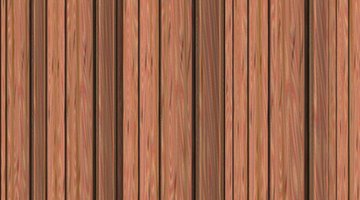How to Repair Exterior Cedar Siding
The usefulness of cedar for exterior applications, such as siding and fencing, is due to its exceptional weather resistance, but over time, even cedar siding can be damaged from exposure to moisture and ultraviolet (UV) rays. Moreover, insects and birds can bore holes and moisture can cause boards to warp and crack.

Wood cleaner can be used to remove sun-damaged wood fibers and smaller cracks and holes can be filled with exterior wood putty, but badly damaged siding boards need to be removed and replaced with new, intact material.
Things You Will Need
- Wood cleaner
- Roller or sprayer
- Nylon scrub brush
- Wood putty
- Putty knife
- 120-grit sandpaper
- Pry bar
- Slater's ripper
- Hacksaw blade saw
- Circular saw
- Corrosion resistant nails
- Hammer
Removing Sun Damaged Wood Fiber
-
Mix a solution of wood cleaner. Wood cleaner is generally sold in a concentrated formula. Follow the manufacturer's instructions regarding the proper dilution to use for removing sun damaged wood fiber.
-
Wet the wood with a hose, and apply the wood cleaner with a roller or sprayer. Leave the wood cleaner on the wood for 15 to 30 minutes.
-
Scrub the siding vigorously with a nylon scrub brush. Scrubbing should remove the grayed and sun damaged wood fiber and leave the healthy underlying wood intact.
-
Rinse the siding down thoroughly with water.
Repairing Minor Defects in Cedar Siding
-
Use a putty knife to apply exterior wood putty to smaller cracks or holes in siding. Work the putty down into the holes, and smear the putty over the top and edges of the defect.
-
Follow the manufacturer's instructions regarding dry time. Smaller repairs, like nail holes, require only a couple of hours, while wider, deeper repairs can require 24 hours to cure completely.
-
Use a piece of 120-grit sandpaper to smooth the dry putty. Work the putty with the sandpaper until it lies flush with the surface of the cedar siding.
Removing and Replacing Badly Damaged Cedar Siding
-
Use a pry bar to lift the siding board to expose the nail shafts.
-
Pull the nails with a slater's ripper, or cut them with a hacksaw blade saw. A slater's ripper is a specialized tool you can slide under the siding and use to hook and pull the nails out. A hacksaw blade saw is a narrow, toothed saw blade mounted to a handle. Slide the hacksaw blade saw underneath the siding and use it to saw the exposed nail shafts. Remove the freed piece of damaged cedar siding.
-
Use a circular saw to cut the board to length, and fasten it in place with nails. The length of nail you use will depend on the thickness of the siding. Always use corrosion resistant nails when working with cedar wood. Galvanized, hot-dipped zinc coated, and aluminum nails are all appropriate. Follow the existing nail patterns to create a consistent appearance.
Tip
Cedar can darken over time. If your cedar siding has turned dark, use wood brightener to restore the natural color and luster of the wood.
Warning
Wood cleaner and wood brightener contain chemicals that can harm skin and eyes. Wear protective clothing, including eye wear and rubber gloves, when working with these products.
The Drip Cap
- The usefulness of cedar for exterior applications, such as siding and fencing, is due to its exceptional weather resistance, but over time, even cedar siding can be damaged from exposure to moisture and ultraviolet (UV) rays.
- Wood cleaner can be used to remove sun-damaged wood fibers and smaller cracks and holes can be filled with exterior wood putty, but badly damaged siding boards need to be removed and replaced with new, intact material.
- Mix a solution of wood cleaner.
- Wood cleaner is generally sold in a concentrated formula.
- Follow the manufacturer's instructions regarding the proper dilution to use for removing sun damaged wood fiber.
- Use a circular saw to cut the board to length, and fasten it in place with nails.
References
Writer Bio
Robert Howard has been writing professionally since 2004 and writes a weekly column for the "Synthesis," a Chico, Calif.-based newspaper. He maintains a blog and has published articles and works of fiction in a variety of different print and online magazines. Howard holds a Bachelor of Arts in visual arts from the University of California, San Diego.
Photo Credits
- panel image by Dave from Fotolia.com
- panel image by Dave from Fotolia.com
More Articles



